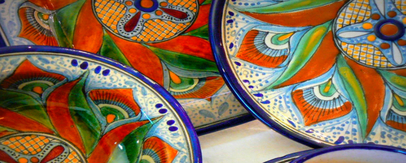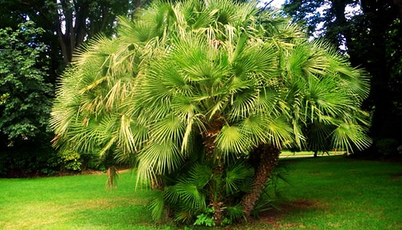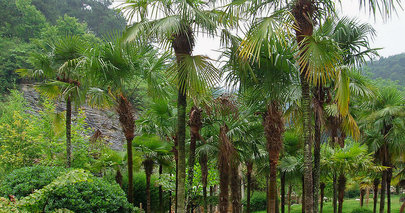
tel: 512 280-1192 thursday, august 27, 2015
Nursery Notes: Palm trees on sale 25% off all Mediterranean
Fan Palms, Windmill Palms, Mexican Fan Palms, Sago Palms,
Canary Island Date Palms. Reg. price: 3 gal. $34.99; 7 gal. $80;
15 gal. $125; 30 gal. $250. / Also all pottery 25% off - and this
includes the colorful Talavera from Mexico (see photo below).
Bougainvilleas in stock: 1 gal; $9.99; hanging baskets $19.99.

DIY - Envy-inducing planters: While seated on her deck with
a glass of wine in hand, Michelle Slatalla supervises her daugh-
ters as they spray paint an urn, and turn it into something beaut-
iful, with some pretty succulents planted in a circle around the
centerpiece of a pony-tail palm. Gardenista

Japanese Gardens, the landscape of flaws: 'Although many
aspects of Japanese culture are defined by restraint, orderliness
and perfection, gardens do not necessarily follow a strictly mani-
cured schema. Rather, the layout and organization are informed
by the principles of the ancient Japanese philosophy of wabi-sabi,'
writes Danica van de Velde in Kinfolk
___________________________________________________
Central Texas Gardener: Summer to Fall Vegetables. Learn
how to transition from tomatoes to lettuce. On tour, meet incred-
ible succulents and cacti. Sat., 4 p.m. & Sun. at 9 a.m. KLRU

Top Palms for Austin's Gardens
by Chris Winslow
One group of trees long associated with drought and desert condi-
tions is the palm tree. You can also find palms doing perfectly
well in equatorial rain forests.
Here in central Texas, we happen to have both of these climates.
Some years we have drought. Others, such as this year, we have
rain aplenty.
To complicate this further, we have winters where temperatures
fall into the teens and single digits. Are any palm trees so incred-
ibly versatile and adaptable that they can handle such variations
in temperature and climate? Thankfully… yes! I can heartily re-
commend the Mediterranean Fan Palm, and the Windmill Palm.
____________________________________________________
The Mediterranean Fan Palm (Chamaerops humilis) is native
to the western Mediterranean region, growing along the coasts
of Portugal, Spain, Italy, France, and south along the coastline of
Africa. (pictured above)
Chamaerops is a clumping palm that grows very slowly. In the
Chamaerops is a clumping palm that grows very slowly. In the
Austin area, it is rare to see one taller than 10 feet.
They do well in full to partly sunny locations, and once estab-
lished, need very little water to keep them happy. There is a
beautiful specimen of the Fan Palm at the southeast corner of
Brodie and Capistrano (Shady Hollow).
Architecturally, the Mediterranean Fan palm makes a striking
addition to any landscape. The foliage can be pruned up to
feature the main and side trunks, or can be left alone to form a
dense bush or screen.

(Trachycarpus Fortunei by Fanghong - wiki)
The Windmill palm (Trachycarpus fortunei), native to central
China, has just one trunk. This palm has been in cultivation for
thousands of years and can handle extremely cold weather.
Like the Mediterranean fan palm, the Windmill palm has palmate
Like the Mediterranean fan palm, the Windmill palm has palmate
leaves, and grows to an average height of 10 to 12 feet. It is shade
and sun tolerant, and is easily adaptable to our central Texas land-
scapes. Look for some beautiful specimens at the far south end
of Pinehurst Drive in Onion Creek.
So, we have two palms that can take our summers and our winters.
(Many palm websites place their cold tolerance close to zero.)
Cold, heat, and drought tolerant, as well as being absolutely beau-
tiful. What more can we ask for? Happy gardening everyone!


Please contact newsletter editor Darrel Mayers (pictured above)
with any ideas for articles or interesting links:
internationalrain@yahoo.com
(hitting 'reply' to this email won't work)Visit the website: Its About Thyme facebook
Visit the nursery:11726 Manchaca Road, Austin, 78748